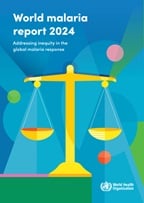Treatment
Each year, an estimated 600 000 people die from malaria – a treatable disease. Effective case management requires both early diagnosis and prompt treatment. The best available treatment, particularly for Plasmodium falciparum malaria, is artemisinin-based combination therapy (ACT).
The primary objective of treatment is curing the infection by ensuring the rapid and full elimination of Plasmodium parasites from a patient’s bloodstream. This also prevent an uncomplicated case of malaria from progressing to severe disease or death. From a public health perspective, effective treatment also minimizes transmission of the infection to others by reducing the infectious reservoir and by preventing the emergence and spread of resistance to antimalarial medicines.
Patients with suspected malaria should have parasitological confirmation of diagnosis with either microscopy or rapid diagnostic test (RDT) before antimalarial treatment is started. Treatment based on clinical grounds should only be given if diagnostic testing is not immediately accessible within 2 hours of patients presenting for treatment. Prompt treatment – within 24 hours of fever onset – with effective and safe antimalarial is necessary to effect a cure and prevent life-threatening complications.
ACTs combine 2 active pharmaceuticals with different mechanisms of action: an artemisinin derivative extracted from Artemisia annua and a partner drug. WHO does not support the promotion or use of Artemisia plant material (such as teas, tablets, or capsules) for malaria prevention or treatment.
Use of oral artemisinin-based monotherapy is considered a contributing factor to the development and spread of resistance to artemisinins. WHO has urged malaria-endemic countries to take measures to halt their production and marketing, and to promote access to quality-assured ACTs for the treatment of falciparum malaria.
WHO Guidelines for malaria
The WHO Guidelines for malaria bring together all current WHO recommendations on malaria in one easy-to-navigate web-based platform. They are a living resource that will be updated periodically as new evidence becomes available. The Guidelines are available in Arabic, English, French and Spanish.
Publications
All →
World malaria report 2024
Each year, the World malaria report serves as a vital tool to assess global progress and gaps in the fight against malaria. This year’s report provides...
/pub-covers/malaria-guideline-cover-eng.tmb-144v.png?sfvrsn=bb6df870_11)
WHO guidelines for malaria
The WHO guidelines for malaria bring together the Organization’s most up-to-date recommendations for malaria in one user-friendly and easy-to-navigate...
Multiple first-line therapies as part of the response to antimalarial drug resistance
Effective malaria case management requires quick access to diagnostics and antimalarial treatments to reduce illness and death. Artemisinin-based combination...
Safety of artemisinin and non-artemisinin antimalarials in the first trimester of pregnancy
Malaria in pregnancy is a significant health problem in malaria-endemic areas. It not only causes substantial childhood morbidity and mortality but also...
Pre-referral treatment with rectal artesunate of children with suspected severe malaria: a field guide
Prompt, effective antimalarial treatment, and supportive care can substantially reduce the rate of mortality from severe malaria. However, many children...
The use of non-pharmaceutical forms of Artemisia
Following an extensive evidence review on the effectiveness of non-pharmaceutical forms of Artemisia conducted in 2019, WHO has issued a position...
